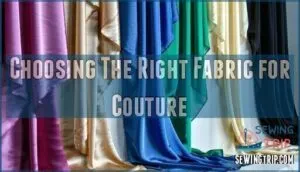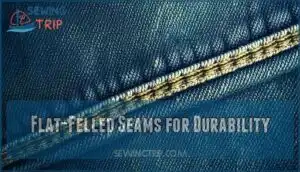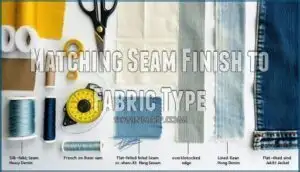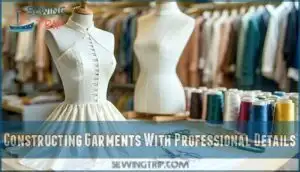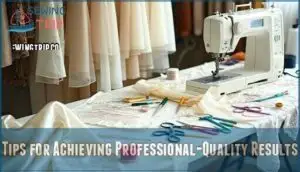This site is supported by our readers. We may earn a commission, at no cost to you, if you purchase through links.
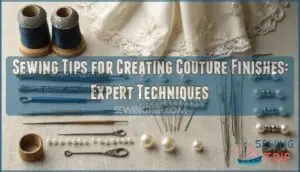
Most sewers master the basics of construction but stop short of the finishing techniques that improve their work from homemade to haute couture. The gap isn’t about expensive equipment or inaccessible materials—it’s about understanding which techniques matter most and where to invest your attention.
Learning to finish garments with couture-level precision transforms not just how your clothes look, but how they move, wear, and make you feel when you put them on.
Table Of Contents
Key Takeaways
- Couture finishing techniques—like hand-sewn embellishments, French seams, and Hong Kong finishes—transform homemade garments into high-end pieces through precision and attention to invisible details rather than expensive equipment.
- Fabric selection forms the foundation of couture quality, requiring careful consideration of natural versus blended materials, texture, drape coefficients, and care requirements that match your project’s structural needs.
- Professional construction depends on strategic use of interfacing, proper seam allowances (3/8" and 1/4"), and systematic workflow that includes pressing each seam immediately, trimming bulk, and working in an organized sequence.
- The difference between amateur and couture work lies in deliberate finishing touches—understitching, hand-tacked linings, custom labels, and structural elements like shoulder pads that sculpt fabric into garments shaped specifically for the body.
Essential Couture Sewing Techniques
Couture sewing isn’t just about following patterns—it’s about mastering techniques that transform fabric into something special. The hallmarks of high-end construction include hand-sewn embellishments, perfectly fitted seams, and structural details that you won’t find in ready-to-wear garments.
Here are the techniques that separate haute couture from homemade projects.
Mastering Hand-Sewn Embellishments
When you slip a needle through silk and anchor a single sequin by hand, you’re not just decorating fabric—you’re mastering a technique that separates true couture from everything else on the rack.
Handsewn embellishments demand patience and precision. Thread selection matters—silk thread for delicate work, polyester for embellishment durability.
Bead placement should follow your design’s rhythm, while sequin techniques and crystal application require consistent tension.
This hand finishing transforms garments, adding that couture touch that no machine can replicate.
Crafting Princess Seams for Tailoring
Princess seams sculpt fabric to your body’s natural curves without a single dart, giving you the kind of fitted silhouette that whispers custom-made. Seam placement runs vertically from shoulder or armhole to hem, allowing curve manipulation for bust adjustment and silhouette shaping.
Getting these seams right takes patience—you’ll need to blend each section smoothly where they meet.
Once you’ve got the hang of it, you’ll be shaping garments with the kind of precision that sets high-end tailoring apart.
Handcrafted Buttonholes and Closures
Once you’ve shaped your fabric with princess seams, the next step in couture craftsmanship is finishing those closures by hand—and nothing says "made with care" quite like a buttonhole you stitch yourself. Hand-crafted buttonholes rely on buttonhole stitch types that lock edges with tight, even loops.
Bound buttonholes create a refined couture look, and if you’re after something more decorative, handmade frog closures deliver that artistic touch.
Thoughtful closure placement keeps everything balanced, while adding a shank when you attach buttons lets them move naturally with the fabric.
Master these hand stitching and hand finishing details, and you’ll achieve the hallmark of true couture sewing.
Using Interfacing for Structure
Once you’ve finished those hand-stitched buttonholes, interfacing steps in as your garment’s hidden support system—the structure that keeps collars crisp and waistbands from sagging over time.
Getting professional results comes down to picking the right type:
- Interfacing types match your fabric weight—woven for structured pieces, knit for stretch
- Fusible vs sew-in depends on delicate fabrics (sew-in won’t damage silk)
- Grain direction follows your fabric to prevent puckering
- Layering interfacing builds structure without stiffness in couture sewing techniques
Choosing The Right Fabric for Couture
Choosing the right fabric is where couture truly begins. The material you select sets the foundation for every seam, embellishment, and finished detail that follows.
Here are the core considerations that determine whether your fabric choice will elevate or undermine your design.
Selecting Natural Vs. Blended Fabrics
Fabric selection shapes every couture project from the ground up. Natural fabrics like silk and organic cotton offer excellent breathability and biodegradability, but cotton production can consume up to 2,700 liters of water per garment.
Blended fabrics combine performance benefits—moisture-wicking, wrinkle resistance, and blend durability—while reducing costs by 30% to 50% compared to pure luxury fibers. However, recycling challenges arise when synthetics and naturals mix, with most blends ending in landfills.
Considering the environmental footprint of different materials is essential for sustainable fashion. Weigh fiber sustainability against your project’s needs for quality fabrics in couture sewing.
Evaluating Fabric Texture and Comfort
When you’re choosing quality fabrics for couture, tactile measurement and sensory analysis matter as much as visual appeal. Lightweight fabrics like silk score high on comfort indices when bending rigidity stays low and drape coefficients fall between 0.4 and 0.8.
Natural fabrics and blended fabrics each offer distinct comfort trends—pile textures boost pleasure ratings by up to 44%, while fabric assessment shows premium materials maintain less than 3% permanent stretch after repeated wear.
Evaluating fabric color fastness is also key for maintaining garment appearance.
Understanding Fabric Care Requirements
When you invest hours in couture sewing, label compliance and proper care keep your garments immaculate for years. Natural fabrics like silk and wool need gentle couture washing in cold water, while blended fabrics tolerate mild machine cycles.
Prewashing prevents fabric fraying and shrinkage before construction begins. Master stain removal techniques early, use low-heat drying techniques to protect delicate fibers, and adopt smart storage solutions—padded hangers for structured pieces, flat folding for knits—to preserve your handcrafted work.
Seam Finishing Methods for a Luxe Look
The way you finish your seams can make the difference between something that looks homemade and something that feels truly luxurious. Your choice of seam finish depends on the fabric you’re working with and the look you want to achieve.
Here are the core techniques that’ll transform your seams from basic to beautifully finished.
French Seams for Sheer and Lightweight Fabrics
When you’re working with delicate silks, organzas, or fine batistes, a French seam becomes your secret weapon for clean, enclosed edges that won’t fray or show through the fabric. This couture sewing technique encloses raw edges within the seam itself, preventing bulkiness while creating a polished finish.
For curved seam finishes, clip carefully before your second pass. Proper lightweight fabric handling and sheer fabric selection help your French seam variations stay crisp without adding weight.
Flat-Felled Seams for Durability
If you need a seam that can stand up to years of wear, washing, and real-world stress—think workwear, denim, or children’s clothing—the flat-felled seam is the workhorse you’re looking for. This durable seam finish encases raw edges completely, creating visible seams with parallel topstitching options that add both strength and style.
It’s a favorite in industrial applications and couture sewing alike. While curved seams require extra care when folding, flat-felled seams deliver peerless durability testing results that prove their worth.
Hong Kong Seams for Polished Edges
Think of the Hong Kong seam as the couture world’s secret weapon—a bias-bound finish that wraps raw edges in a whisper-thin envelope of matching or contrasting fabric, delivering that unmistakable luxury look you’d find inside a designer jacket.
This sophisticated seam finishing technique involves careful bias tape selection and fabric compatibility checks. You’ll master curved edge application while exploring decorative variations through color coordination.
It’s couture sewing at its finest—transforming functional seam finishes into elegant details.
Matching Seam Finish to Fabric Type
Your fabric choice dictates which seam finish will look polished and hold up to wear—pair the wrong technique with the wrong material, and you’ll end up with puckered edges or frayed disasters instead of that clean, couture-worthy interior.
Fabric weight matters when choosing between techniques: French seams work beautifully for finishing seams in silk and sheer fabrics, while flat-felled seams suit heavier wovens.
Think about how easily your fabric frays—anything with a loose weave needs an enclosed finish to keep edges from unraveling over time.
The type of fabric also shapes your approach: knits need more flexibility than wovens, and if you’re after that polished, professional look inside a lined jacket, Hong Kong seams deliver the visual impact you’re looking for.
Constructing Garments With Professional Details
The final step in couture sewing is adding those professional details that separate homemade garments from designer pieces. Techniques like tailoring with shoulder pads, crafting crisp collars and linings, and strategic padding transform fabric into structured, polished clothing.
Here’s what these finishing touches can do for your work.
Applying Tailoring Techniques (Shoulder Pads, Seam Tape)
Tailoring techniques like shoulder pads and seam tape transform flat fabric into structured, couture-quality garments. Shoulder pad types range from triangular for crisp silhouettes to rounded for softer contours, with thickness between 1/8″ and 1″. Position the back section 1 to 1.5 cm beyond the shoulder seam for proper balance.
Seam tape materials—commonly 0.08mm to 0.12mm thick—reinforce stress points and prevent fraying, improving garment structure and shape while boosting tape durability through multiple wears.
Creating Crisp Collars, Cuffs, and Linings
Collars, cuffs, and linings need the right interfacing to hold their shape and create that crisp, professional edge you see in high-end garments. Choose collar interfacing that bolsters fabric weight without adding bulk.
For cuff construction, understitching techniques keep seams flat and edges sharp.
Full lining in quality fabrics hides interior seams beautifully. Hand finishing along collar points and cuff edges delivers that unmistakable couture sewing polish.
Padding and Shaping for Silhouette
Once you’ve perfected those details, padding becomes your secret weapon for sculpting structure and creating the polished silhouettes that define couture garments. Shoulder pads lift and balance the upper body, while strategic padding materials improve body contouring along princess seams.
These shaping techniques work with your draping fabric to create design integration that flatters naturally. Think of padding as silhouette enhancement that transforms flat cloth into dimensional art.
Tips for Achieving Professional-Quality Results
Achieving couture-quality results comes down to getting the fundamentals right—the small details that separate amateur work from professional garments.
None of this is rocket science, but it does take care and practice. Focus on these fundamentals to turn out garments that look professionally made instead of homemade.
Industry-Standard Seam Allowances
Professional garment-makers swear by seam allowances of 3/8" and 1/4"—not because they’re arbitrary numbers, but because these measurements give you the flexibility to adjust fit while keeping your stitching lines clean and consistent. Here’s your seam allowance guide for achieving a couture finish:
- Use accurate measurement tools to mark consistent seam width
- Consider grading seam allowances to reduce bulk in professional garment construction
- Choose industry seam allowances that accommodate alteration considerations
- Match seam types to fabric weight for a polished result
Efficient Construction Order and Prep
When you map out your sewing steps before you even thread the needle, you’ll save time, avoid mistakes, and watch your garment come together with the kind of ease that separates hobby sewers from couture craftspeople.
Think of efficient construction order as your game plan—batch sewing similar steps (like stitching all darts at once) and prepping cut pieces with interfacing before assembly streamlines your workflow.
This engineered process, borrowed from assembly-line sewing methods, transforms scattered tasks into a smooth, ergonomic workspace rhythm.
Pressing, Trimming, and Workspace Organization
Your finishing work makes or breaks a garment—press seams with intention, cut away bulk carefully, and keep your space organized. Pressing techniques turn flat seams into clean, tailored lines, while trimming tools get rid of lumps that scream homemade.
Good workspace ergonomics and smart organization aren’t extras—they’re what make efficiency tips actually work and bring sewing projects up to professional standards.
- Press each seam immediately after stitching, before crossing with another
- Use sharp shears to grade seam allowances and reduce bulk
- Keep your iron, scissors, and thread within arm’s reach
- Organize tools by task (cutting station, pressing zone, stitching area)
- Clear scraps continuously so you can see what you’re creating
This discipline separates couture sewing techniques from rushed work—professional quality lives in these small, repeated acts of care.
Adding Custom Labels and Final Touches
Every couture piece deserves a signature—custom labels and hand-stitched final touches transform your work from anonymous craft into something undeniably yours. Label placement along the center-back neckline or side seam establishes brand identity, while thread selection for handsewn embellishments adds that couture touch.
Hand finishing invisible hems and tacking linings quietly announces professional intent.
Client personalization—monograms, custom made labels, fabric-covered buttons—elevates custom garments into heirlooms that carry your couture finish forward.
Frequently Asked Questions (FAQs)
How do you prevent puckering on delicate fabrics?
Delicate fabrics can make you feel like you’re walking on pins and needles. Use a fine needle size matched to lightweight fabrics, adjust thread tension to prevent fabric fraying, check feed dogs aren’t pulling unevenly, stabilize woven fabrics with interfacing use, and always test on scraps first.
Respecting fabric grain matters too.
What needle types work best for couture sewing?
Couture sewing demands the right needle for each fabric type. Use sharp needles for woven fabrics and ballpoint for knits.
Needle size matters—choose smaller sizes for lightweight fabrics and larger ones for thicker materials. Specialty needles prevent damage and maintain proper thread tension across different fabric types.
How do you achieve invisible hand stitching?
Invisible hand stitching relies on matching thread selection to your fabric and controlling stitch length—aim for tiny, evenly spaced stitches.
Thread tension control and proper needle type matter too.
Hide knots between fabric layers, and pull gently to sink stitches below the surface for that haute couture finish.
When should you underline versus interline fabric?
Underlining reinforces the entire fabric for added warmth and silhouette impact, while interlining targets specific areas like collars for fabric stability.
Yes, underlining adds both complexity and cost to your project—but in couture sewing, it’s a game-changer for strategic fabric control and elevating your work.
How do you handle pattern adjustments for fit?
Start with muslin fitting to test your pattern on fabric before cutting expensive materials.
Take personal measurements accurately, then make pattern alterations using grading sizes or combining patterns on your dressform for precise customization and adapting styles.
Conclusion
The line between sewing and artistry isn’t drawn with thread—it’s woven through every deliberate choice you make. When you apply these sewing tips for creating couture finishes, you’re not just constructing garments; you’re building a wardrobe that reflects precision and intention.
Each hand-sewn stitch, each pressed seam, each carefully chosen fabric becomes evidence of your commitment to craft. The clothes you create will carry that difference in every wear, moving with you like a second skin rather than simply covering it.
- https://elizabethmadethis.com/seam-finishes/
- https://www.threadsmagazine.com/2019/05/31/couture-hand-stitches-hand-overcasting-stitch
- https://blog.closetcorepatterns.com/couture-seam-finishes-hand-stitches-you-should-know/
- https://www.sewingchanelstyle.com/blog-en/couture-sewing-techniques
- https://alyssaraecreative.com/types-of-edge-finishes-in-sewing/

